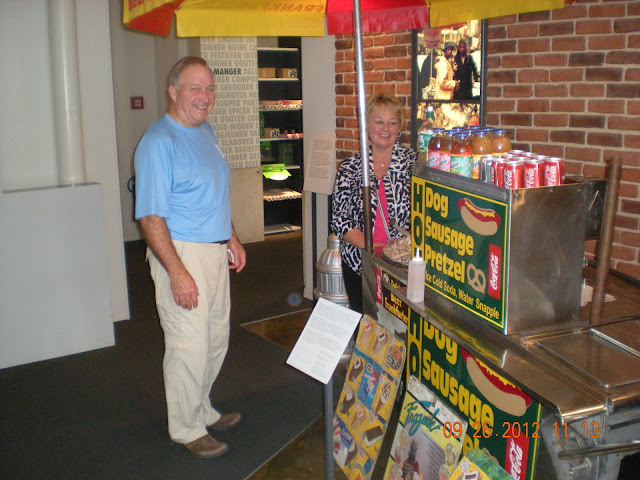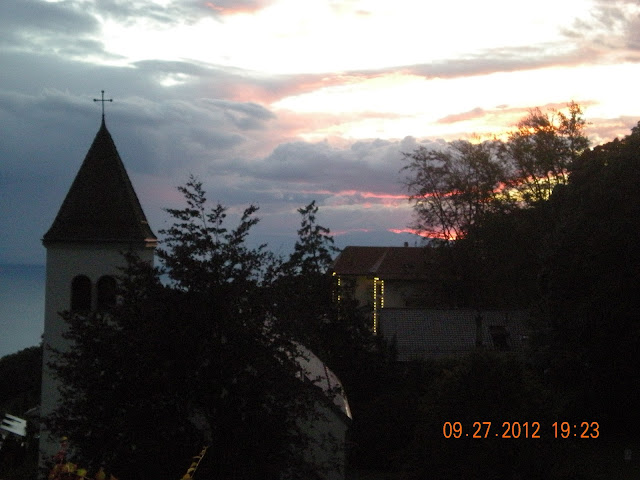Life has been very good to us, allowing us to meet the best friends of our lives as we were raising our kids. Four of these dear people arrived at the Geneva airport, Monday afternoon, Sept 24th. From left to right, Joan, Terri, Greg and Jerry.
They will be touring Switzerland for about 5 days, with some assistance from me. Paula worked this week-someone has to pay for all this as Paula's dad used to say.
Jerry, Terri, Joan and Greg along the Montreux waterfront.
After a relaxing walk along the waterfront we decided to eat lunch, prior to walking to the Chillon Castle. The walk to the castle takes about 45 minutes.
A picture of the Chillon Castle from Lake Geneva. The oldest parts of the castle have not been definitively dated, but the first written record of the castle is in 1005. From the mid 12th century, the castle was home to the Dukes’ of Savoy, and it was greatly expanded in the 13th century by Duke Pietro II. The Castle was never taken in a siege, but did change hands through treaties.
It was made popular by Lord Byron who wrote the poem, The Prisoner of Chillon (1816) about Francois de Bonivard. Bonivard (1496-1570) was a Swiss patriot and political activist. He opposed the Duke of Savoy in his efforts to control Geneva; the duke captured Bonivard and imprisoned him from 1519 to 1521. The experience was not much of a deterrent; Bonivard continued his political activism. In 1530, he was set upon by robbers who eventually turned him over to the Duke of Savoy. In 1530 the duke imprisoned him again, this time underground in the Castle of Chillon. He was released by the Bernese Army when they conquered the canton of Vaud in 1536.
According to the castle website, Chillon is listed as "Switzerland's most visited historic monument".
We spent about 1 1/2 hours touring the castle.
We spent about 1 1/2 hours touring the castle.
Alimentarium (Museum of Food) sponsored by Nestle. (the building was formerly the headquarters for Nestle).
Founded by Nestle, in 1985, the Alimentarium is a food museum.
It holds a permanent exhibition on the theme: “cooking, buying, eating and
digesting”. It broaches diverse topics, such as the transformation of food by
cooking, food safety, major distribution, small-scale and industrial production
or the metabolism of digestion. Food professionals are regularly invited to
answer the visitors' questions.
The Alimentarium gives preference to
temporary interactive exhibitions, particularly cooking workshops. Its
cafeteria proposes dishes in line with the exhibitions presented.
The Alimentarium also describes the history of Nestle, which was
founded by Henri Nestle in 1867, a pharmacist who invented baby powder milk.
Nestle first made itself a name with dairy products and chocolate.
Jerry and Terri, both in the food business, examining this hot dog cart displayed at the food museum.
The hot-dog cart was in use in New York City until February 2001. The vendor, who was originally from Cairo, Egypt, sold warmed pretzels dipped in salt and re-heated hot-dogs. (His permit from the city did not allow him to do any cooking, only re-heating).
Visiting one of the many collections on display. This is a collection of Coke cans and bottles used through out the years.
Lunch at the Alimentarium.
The theme for our lunch was potatoes. All of the dishes, including the desserts, were made with potatoes as the main ingredient.
The Fork and Friends in front of the Alimentarium.
This
fork is a statue of great stature! Made of stainless steel, it is 26 feet high and 4 feet wide. It was designed by Jean-Pierre Zaugg, a sculptor from Neuchatel,
Switzerland and embedded in the lake in February 1995 to commemorate the
Alimentarium’s tenth anniversary. It was initially intended to grace the
lakeshore in front of the Museum for one year.
In 1996, despite backing from
the town of Vevey, the Alimentarium did not obtain authorization for the fork
to stay. Hence it left Lake Geneva for Littau in the Canton of Lucerne, to
embellish the garden outside the Berndorf cutlery factory.
However,
in September 2007, this impressive utensil came home for a temporary exhibition
on cutlery. That same year, a petition confirmed popular desire to keep the fork
in Lake Geneva. The Vevey Town Council joined in the proceedings and this time
the outcome was positive! In autumn 2008, the Canton of Vaud decreed that the
fork could remain as part of the Lake Geneva landscape.
On this day we rented a car to drive to Gruyere (about an hours drive northeast of Vevey) famous for the cheese of the same name.
Here we are walking into the city, they do not allow cars into the main area of the town.
A beautiful fountain on the main street of Gruyere.
The castle, constructed in the 13th century, was home to a long
succession of Gruyere counts. Michel, the last of them, faced financial
difficulties and declared bankruptcy in 1554. The creditors, the towns of
Fribourg and Berne, shared his land between them. The Castle became the
headquarters of the Fribourg bailiffs (1555-1798), then the prefects' residence
until 1848. It was put up for sale in 1849 and became the property of the Bovy
and Balland families, who stayed there in summer and took care of restoration
of the site with their artist friends. In 1938, the State of Fribourg bought
the Castle and opened a museum
The Cailler Chocolate Factory, Nestle's premium chocolate brand.
Our tour of the factory begins in the early 15th century in the land of the Aztecs. It is here that cocoa beans and their incredible power were discovered. Then we "embarked" on a Spanish galleon for the long and perilous journey back to Europe where cocoa quickly became the favorite drink of kings, known as "chocolate". We then journeyed across the centuries to arrive in Switzerland in 1819, when Francois Louis Cailler, the confectioner, had the brilliant idea of working with chocolate to make the candy that is most consumed in the world. We then moved to another room to watch the production line.
Cailler chocolate is made with the fresh milk collected daily from the Gruyeres cows and mixed with the most aromatic cocoa beans, making it arguably the best chocolate in the world.
In 1929 Nestle acquired Cailler.
In 1929 Nestle acquired Cailler.
The best part of the tour, the sampling room. In this room are samples of most of the chocolates that Cailler produces, all to be sampled free.
More chocolates to be sampled.
This picture was taking from the top of Mont-Pelerin, which is reached via a funicular. This mountain sits at an elevation of 2,657 feet, overlooking Vevey and Lake Geneva. At the top of the mountain are two nice restaurants, one is located in the Hotel Miador, a very upscale hotel. The other, Au Chalet, serves authentic Swiss fare. This is the one where we will dine.
From left to right, Terri, Joan and Paula, with Vevey and Lake Geneva in the background.
Our friends, with a magnificent sunset in the background.
Most of us dined on typical Swiss food (fondue).
Friday afternoon we left Vevey, via car, to start the next adventure in France. More to follow.




















Thanks for the blog...like this post..Want to be visit this place....
ReplyDeleteChalet Gstaad
Chalet Switzerland